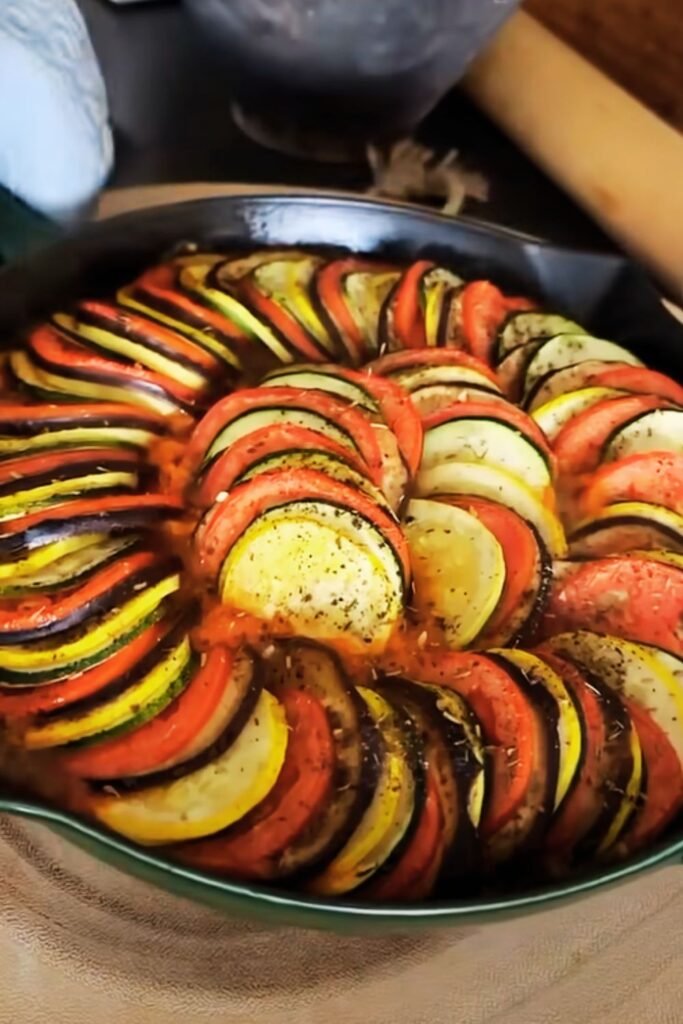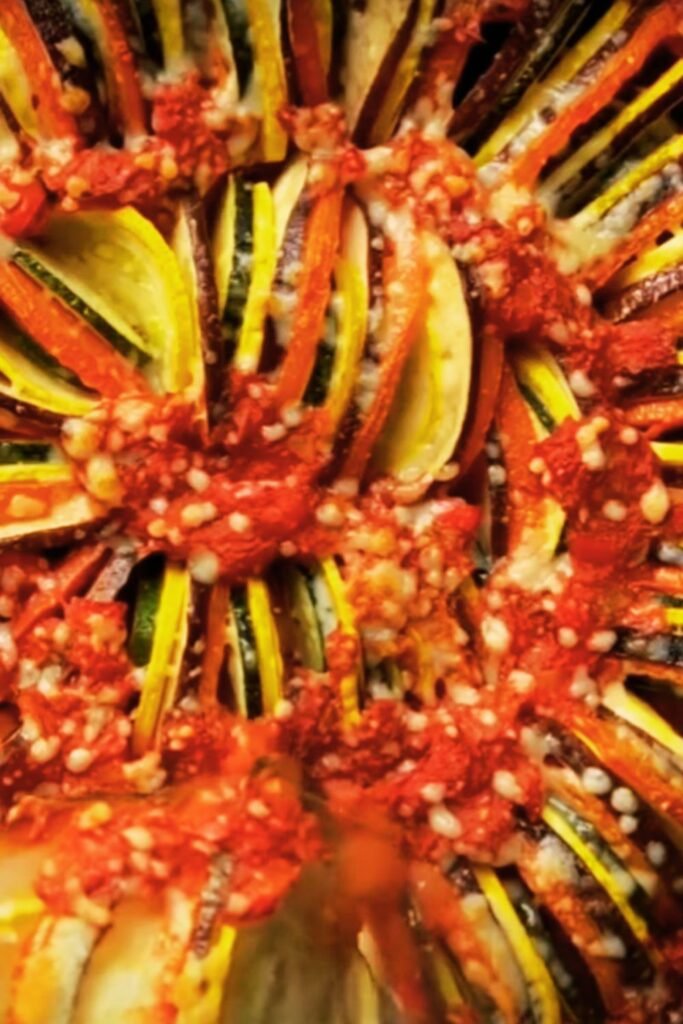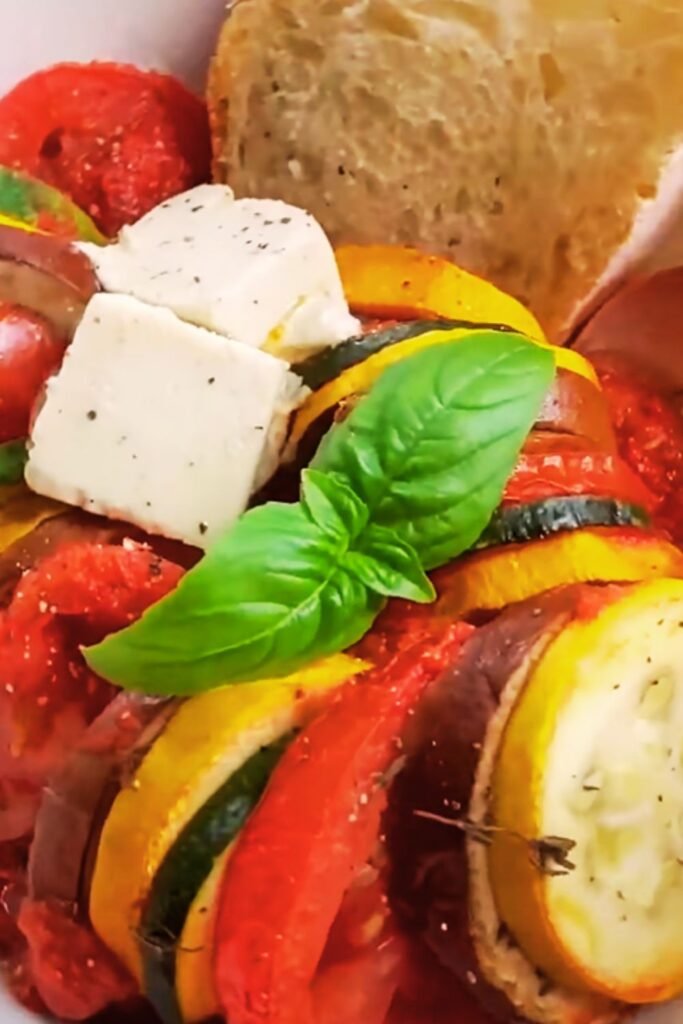When I first tasted authentic ratatouille in a small bistro in Provence, I knew I had to recreate that magical combination of smoky vegetables and creamy textures in my own kitchen. After countless experiments and refinements, I’ve developed what I consider the perfect smoky and creamy ratatouille recipe that captures the essence of traditional French cooking while adding my own innovative twist.
This isn’t your typical ratatouille – I’ve elevated the classic Provençal dish by incorporating smoking techniques and cream elements that transform humble vegetables into a restaurant-quality masterpiece. The result is a dish that’s both rustic and refined, perfect for impressing dinner guests or treating yourself to something extraordinary.
Understanding Ratatouille: More Than Just Vegetables
Traditional Ratatouille: A classic French stewed vegetable dish originating from Nice, typically made with eggplant, zucchini, bell peppers, tomatoes, onions, and herbs.
Smoky Variation: My version incorporates charring and smoking techniques to add depth and complexity to the vegetable flavors.
Creamy Element: Unlike traditional versions, I add cream strategically to create luxurious texture without overwhelming the vegetable essence.
Confit Method: Slow-cooking vegetables in olive oil to achieve maximum flavor concentration and silky texture.
The beauty of ratatouille lies in its versatility and the way it celebrates seasonal vegetables. I’ve learned that the key to exceptional ratatouille isn’t just about combining vegetables – it’s about understanding how each component contributes to the final harmony of flavors.
Essential Ingredients for My Smoky & Creamy Ratatouille
| Ingredient Category | Item | Quantity | Quality Notes |
|---|---|---|---|
| Primary Vegetables | Large eggplant | 1 (about 1.5 lbs) | Choose firm, glossy skin |
| Medium zucchini | 2 | Avoid oversized ones | |
| Red bell peppers | 2 large | Look for thick walls | |
| Yellow bell peppers | 1 large | Adds color contrast | |
| Roma tomatoes | 4 large | Meaty variety preferred | |
| Red onion | 1 large | Sweet variety works best | |
| Aromatics | Garlic cloves | 6 large | Fresh, not sprouted |
| Fresh thyme | 3 sprigs | Mediterranean variety | |
| Fresh rosemary | 2 sprigs | Avoid woody stems | |
| Fresh basil | 1 cup leaves | Genovese variety ideal | |
| Creamy Components | Heavy cream | 1/2 cup | 35% fat content |
| Crème fraîche | 1/4 cup | French-style preferred | |
| Aged Gruyère | 1/2 cup grated | 12-month aged | |
| Oils & Seasonings | Extra virgin olive oil | 1/2 cup | First cold-pressed |
| Sea salt | To taste | Flaky finishing salt | |
| Black pepper | Fresh ground | Tellicherry variety | |
| Smoked paprika | 1 teaspoon | Spanish pimentón |

Equipment and Preparation Essentials
Having the right tools makes all the difference in achieving that perfect smoky and creamy texture. I’ve refined my technique over years of making this dish, and these tools are absolutely essential:
Cast Iron Skillet: My 12-inch Lodge cast iron skillet is perfect for achieving those beautiful char marks on vegetables. The even heat distribution creates consistent browning.
Grill Pan: For the smoking effect, I use a ridged grill pan that allows me to char vegetables while maintaining their structure.
Heavy-Bottomed Dutch Oven: Essential for the slow-cooking phase where all flavors meld together beautifully.
Sharp Chef’s Knife: Precision cutting ensures even cooking times for all vegetables.
Wooden Spoon: Metal utensils can scrape the seasoned surface of cast iron, so I always use wood.
Step-by-Step Cooking Method
Phase 1: Preparing the Vegetables
I start by preparing each vegetable separately, as they all have different cooking requirements and I want to maximize the flavor of each component.
Eggplant Preparation: I slice the eggplant into 1-inch cubes and salt them generously. This draws out excess moisture and any potential bitterness. After 30 minutes, I pat them completely dry with paper towels.
Pepper Charring: Using my grill pan over high heat, I char the bell peppers until the skin blisters and blackens in spots. The key is rotating them frequently to achieve even charring. Once charred, I place them in a bowl covered with plastic wrap – the steam helps loosen the skins.
Zucchini Treatment: I cut zucchini into half-moon slices about 1/2 inch thick. The key is not to salt these as they’ll release too much moisture during cooking.
Tomato Preparation: I core and roughly chop the tomatoes, removing excess seeds while preserving the flavorful gel around them.
Phase 2: The Smoking Process
This is where my recipe truly differs from traditional ratatouille. I use controlled charring to create that distinctive smoky flavor that elevates the entire dish.
Heat my cast iron skillet over medium-high heat and add 2 tablespoons of olive oil. Working in batches, I char each vegetable type separately:
- Eggplant: 4-5 minutes per side until golden brown with char marks
- Zucchini: 3 minutes per side until tender with grill marks
- Onions: 6 minutes until caramelized edges appear
- Garlic: Just 1 minute until fragrant, being careful not to burn
Each vegetable gets transferred to a large plate as it finishes, creating layers of smoky flavor that will combine beautifully later.

Phase 3: Building the Creamy Base
In my Dutch oven, I create the foundation that will bring everything together in creamy harmony.
I warm 1/4 cup olive oil over medium heat and add the peeled, charred peppers first. They release their sweet, smoky juices and create the base flavor profile. After 5 minutes, I add the chopped tomatoes along with fresh thyme and rosemary.
The magic happens during the next 15 minutes as the tomatoes break down and concentrate, creating a rich, thick sauce. I stir occasionally, allowing some bits to stick slightly to the bottom – these caramelized bits add incredible depth.
Phase 4: Combining and Slow-Cooking
This is where patience pays off. I add all the charred vegetables back to the Dutch oven, gently folding them into the tomato base. The key is maintaining some texture – I don’t want everything to turn into mush.
I reduce heat to low and cover partially, allowing steam to escape while keeping moisture in. This slow-cooking phase takes about 45 minutes, and I stir gently every 10 minutes to prevent sticking.
During the last 10 minutes, I create my creamy element by whisking together the heavy cream and crème fraîche in a small bowl. I temper this mixture by adding a few spoonfuls of the hot ratatouille, then fold it back into the pot along with the grated Gruyère.
Flavor Enhancement Techniques
| Technique | Purpose | Timing | Result |
|---|---|---|---|
| Salt Curing | Remove eggplant bitterness | 30 min before cooking | Concentrated flavor |
| High-Heat Charring | Create smoky notes | During prep phase | Complex depth |
| Herb Layering | Build aromatic complexity | Multiple stages | Balanced herbaceous notes |
| Cream Tempering | Prevent curdling | Final 5 minutes | Silky integration |
| Cheese Melting | Add richness | Last 2 minutes | Luxurious texture |
| Resting Period | Allow flavors to meld | 10 min off heat | Harmonized taste |
Nutritional Benefits and Health Considerations
My smoky and creamy ratatouille isn’t just delicious – it’s packed with nutrients that make it a wholesome choice for any meal.
Antioxidant Powerhouse: The variety of colorful vegetables provides a spectrum of antioxidants. Eggplant contains nasunin, which protects brain cells, while bell peppers deliver vitamin C in abundance.
Heart-Healthy Fats: The olive oil and moderate cream content provide monounsaturated fats that support cardiovascular health when consumed as part of a balanced diet.
Fiber Content: Each serving provides approximately 8 grams of dietary fiber, supporting digestive health and helping maintain stable blood sugar levels.
Vitamin Profile: This dish is rich in vitamins A, C, and K, along with folate and potassium from the diverse vegetable content.
Serving Suggestions and Pairings
I’ve discovered numerous ways to serve this versatile dish, each highlighting different aspects of its smoky and creamy character.
As a Main Course: I serve generous portions over creamy polenta or garlic-infused quinoa. The contrast between the rustic vegetables and refined grains creates a satisfying, complete meal.
Side Dish Excellence: This ratatouille pairs beautifully with grilled lamb, roasted chicken, or pan-seared fish. The smoky flavors complement proteins without overwhelming them.
Breakfast Innovation: I’ve found that leftover ratatouille makes an incredible base for shakshuka-style eggs. I reheat it gently and crack eggs directly into the mixture for a Mediterranean-inspired breakfast.
Pasta Integration: Tossed with wide ribbon pasta like pappardelle, this ratatouille creates a restaurant-quality vegetarian entrée that satisfies even the most devoted carnivores.

Storage and Reheating Guidelines
| Storage Method | Duration | Container Type | Reheating Instructions |
|---|---|---|---|
| Refrigerator | 4-5 days | Glass containers | Gentle stovetop, add splash of cream |
| Freezer | 3 months | Freezer-safe bags | Thaw overnight, reheat slowly |
| Meal Prep | 3 days | Portion containers | Microwave 60% power, stir halfway |
| Leftover Enhancement | Same day | Keep warm | Add fresh herbs before serving |
The beauty of this ratatouille is that it actually improves with time. The flavors continue to develop and meld, making day-two leftovers often better than the original meal. I always make a double batch because I know it will disappear quickly.
Seasonal Variations and Adaptations
Throughout the year, I adapt this recipe to showcase the best seasonal produce available.
Summer Abundance: During peak summer, I add fresh corn kernels and cherry tomatoes for sweetness and color variation. Yellow summer squash can substitute for some of the zucchini.
Fall Transformation: I incorporate roasted butternut squash and add a pinch of cinnamon to complement the smoky flavors. Root vegetables like parsnips add earthiness.
Winter Comfort: I increase the cream slightly and add cannellini beans for protein, creating a more substantial cold-weather dish.
Spring Freshness: Early spring vegetables like baby artichokes and fresh peas bring brightness to the rich, smoky base.
Troubleshooting Common Issues
Watery Texture: This usually results from not properly salting the eggplant or adding vegetables that haven’t been properly dried. Always pat vegetables completely dry before cooking.
Bitter Flavors: Overcooking garlic or using old herbs can create bitterness. Keep garlic cooking time minimal and use fresh herbs whenever possible.
Cream Separation: Adding cold cream to hot vegetables can cause curdling. Always temper the cream by warming it gradually with hot liquid from the pot.
Lack of Smoky Flavor: Insufficient charring or using low heat prevents proper caramelization. Don’t rush the charring process – proper browning takes time.
Questions and Answers
Q: Can I make this ratatouille without cream for a vegan version?
I absolutely understand the desire for a plant-based version! You can substitute the cream with cashew cream (soak 1 cup raw cashews for 4 hours, then blend with 1/2 cup water until smooth) or use full-fat coconut milk. The texture will be slightly different, but the smoky flavors will still shine through beautifully.
Q: How do I achieve the perfect char without burning my vegetables?
The key is using medium-high heat rather than maximum heat, and ensuring your pan is properly preheated. I let my cast iron skillet heat for 3-4 minutes before adding oil. Watch for color changes rather than timing – you want golden brown with darker spots, not black char.
Q: Can I prepare components ahead of time for easier weeknight cooking?
Absolutely! I often char all the vegetables on Sunday and store them separately in the refrigerator. During the week, I can have this ratatouille ready in about 30 minutes by just combining and slow-cooking the pre-charred components.
Q: What’s the best way to cut vegetables for even cooking?
Consistency is crucial. I cut all vegetables into roughly 1-inch pieces, which ensures they cook at similar rates. For zucchini, half-moons work better than cubes because they hold their shape during the slow-cooking process.
Q: How can I intensify the smoky flavor even more?
For extra smokiness, try adding a small amount of smoked salt instead of regular salt, or include a finely diced chipotle pepper in adobo sauce. You can also finish the dish with a few drops of liquid smoke, though I find the charring technique provides sufficient smokiness.
Q: Is it normal for the ratatouille to look rustic rather than perfectly uniform?
Yes! That’s exactly what you want. Ratatouille should look rustic and homestyle – it’s not meant to be a perfectly uniform mixture. The varied textures and slightly irregular vegetable pieces are part of its authentic charm.
Q: Can I double or triple this recipe for entertaining?
I regularly double this recipe for dinner parties. Use a larger Dutch oven and increase cooking times slightly – the vegetables will need a bit longer to char in batches, and the slow-cooking phase might extend to 60 minutes instead of 45.
Q: What should I do if my ratatouille turns out too acidic?
Sometimes tomatoes can be quite acidic. I balance this by adding a pinch of sugar or a drizzle of honey during the slow-cooking phase. The cream also helps neutralize acidity, so don’t skip that component.
This smoky and creamy ratatouille has become my signature dish, one that never fails to impress and satisfy. The combination of traditional French techniques with modern flavor enhancements creates something truly special – a dish that honors the past while embracing innovation. Every time I make it, I’m reminded why I fell in love with cooking in the first place: the ability to transform simple ingredients into something extraordinary through patience, technique, and a little bit of culinary creativity.